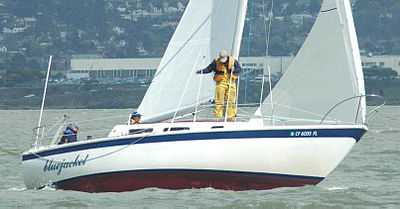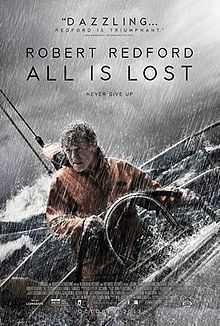Cal Yachts

Cal Yachts (aka Jensen Marine) was a manufacturer of performance oriented fiberglass sailboats from the 1960s to the 1980s. The Costa Mesa, California, headquartered company was founded in 1957, among the earliest of all-fiberglass, mass-production sailboat builders. Although the brand has been out of production for three decades, the existing fleet is still substantially active in racing and cruising.
History
Cal Yachts was originally named the Jensen Marine Corporation after the founder, Jack Jensen, a pioneer in fiberglass boat building. He sold his company to Bangor Punta Corporation in 1968. Jensen later produced Ranger sailboats and a line of molded fiberglass recreational vehicles called "Balboa".
Nearly 18,000 boats were built under the Cal brand name. There were many different models, but perhaps the most famous is the Cal 40. The first of the ultra-light, production ocean racers, the Cal 40 was inspired by ocean racer George Griffith, of the Los Angeles Yacht Club, and was truly first sketched by him in 1962 on the back of a cocktail napkin. Following Griffith's inspiration, the Cal 40 was designed by naval architect C. William "Bill" Lapworth. Griffith sought out Jack Jensen to build the first boat, Persephone, but had to guarantee the sale of ten boats, which was quickly accomplished, even before the first boat was out of the mold. Lofting was performed by Willis Boyd. A major undertaking for its time and radically different from other production racing sailboats with its fin keel separated from a spade rudder mounted well aft, the Cal 40 astonished the yachting community by Don Salisbury's Hull #3 "Psyche" winning first overall in the 1965 Transpac with Griffith aboard. The Cal40 continues to rack up an impressive string of ocean racing victories more than four decades after its initial launch, winning major competitions such as the Newport-Bermuda Race as recently as 2008. Among other ocean racing classics, Cal 40s still compete as a class in the Transpac from Los Angeles to Honolulu and in 2005 recorded 14 entries, more than any other production sailboat at any time in the century-long history of this, America's longest-running ocean yacht race.
In competition for the most famous of the Cal line, is the Cal 34, also designed by Bill Lapworth. the Cal 34 has its own line of trophies to its credit as a racer, and was one of the longest running production boats ever made. it was originally designed as a well built comfortable coastal cruising boat with a nice roomy cabin layout, large V-berth and large cockpit. and it was fast!. There were upgrades and improvements to the 34 over the last few years of its production to make it better for bluewater and long range cruising, with the hull being strengthened, a redesigned cockpit with a strong bridgedeck and the steel support beam replaced with aluminum, but the hull shape remained the same. with the 34-III model being last produced in 1979, it was then and still is a highly rated offshore cruising boat. with the Mk III model having its hull laid up stronger it could take more ballast but with sail area slightly reduced, so with having an SA/Disp ratio of 16.38, a Disp/L ratio of 259.08 and a ballast/disp ratio of 45.58, it is set up well to be a much stronger ocean cruiser than the first model, with good performance in speed and pointing ability, and a more than adequate righting ability. the later models had, in addition to more ballast, a higher aspect rig, and a newer and more comfortable cabin layout.
Also worthy of mention as a popular model, is the Cal 27.
The Jensen-Lapworth collaboration resulted in some competitive racer/cruiser sailboats. If the PHRF ratings below are compared to those of recent hull designs, it will be found that the Cal designs are relatively fast boats. This is one of the reasons these ruggedly built and surprisingly affordable boats remain popular nearly fifty years after they first appeared in the recreational marine marketplace.
The Cal-20 Fleet recently celebrated its 50th year concluding its National Championship regatta with 53 boats entered at Alamitos Bay and Long Beach Yacht Clubs in Southern California.
Models
- CAL 9.2 - PHRF 174
- CAL T/4 - PHRF 252
- CAL20 - PHRF 276 http://www.cal20.com
- CAL22 - PHRF 258
- CAL24 - PHRF 240
- CAL2-24 - PHRF 228
- CAL24 MK-3(Hunt) - PHRF 228
- CAL25 - PHRF 222 http://www.cal25.com
- CAL25 MK-2 - PHRF 216
- CAL27 - PHRF 198
- CAL27-2 - PHRF 204
- CAL27-3 - PHRF 192
- CAL27T - PHRF 186
- CALT2 - PHRF 195
- CAL28 - PHRF 192 http://www.stirlinglaw.com/cal28
- CAL28 Mk2 - PHRF 192
- CAL29 - PHRF 180
- CAL2-29 - PHRF 180
- CAL30 - PHRF 192
- CAL30-3T - PHRF 153
- CAL2-30 - PHRF 180
- CAL3-30 - PHRF 168
- CAL31 - PHRF 162
- CAL33 - PHRF 156
- CAL34 - PHRF 174
- CAL34T - PHRF 165
- CAL34-1 - PHRF 174
- CAL34-2 - PHRF 168
- CAL34-3 - PHRF 168
- Cal35 MK-2 PHRF 180
- CAL36 - PHRF 150
- CAL36T - PHRF 141
- CAL37 - PHRF 114
- CAL39 - PHRF 108
- CAL39-1 - PHRF 102
- CAL39-2 - PHRF 114
- CAL39-2T - PHRF 108
- CAL40 - PHRF 114 http://www.cal40.com/
- CAL43 - PHRF 108
- CAL43T - PHRF 102
- CALCR46-MK-1 - PHRF 162
- CALCR46-MK-2 - PHRF 156
- CAL48 - PHRF 96
- CAL9.2 - PHRF 165
- CAL9.2R - PHRF 159
- CALCR35 - PHRF 192
- CALCR36 - PHRF 156
Cal 25
The Cal 25 is one of the most popular and successful Cals ever built. Over 2000 hulls were constructed, and although they were designed over 40 years ago, they remain one of the most popular one-design racing yachts throughout the U.S. with fleets in Detroit, MI; Port Huron, MI; Annapolis, MD; New Orleans, LA; Los Angeles Area, San Francisco Bay, San Diego, CA and more. They are also one of the first boats to be designed as Racer/Cruisers which have a cruising interior, but are set up for racing. A Cal 25 sailed by Ron Hatt of the Metropolitan Yacht Club corrected out 2nd in the Oakland to Catalina race. They are also quite affordable, and relatively inexpensive to maintain. A well equipped racing Cal 25 can be had for around $4000. Problem areas include the plywood cored deck, and transom. But the hull is solid glass and rarely has any problems. SoCal PHRF has over 20 registered as racing in 2011, plus an active one-design fleet in Long Beach, CA.
Motorhomes
The Balboa recreation vehicle is a 20 foot, fiberglass shell built on several different chassis including Dodge, Ford, & Chevy. Production total is not currently known. Produced from about 1968 to 1974, the Balboa included a rear-entry walk-through design, plenty of head room for even a 6-foot person, and it could sleep five people.
In popular culture

All Is Lost, the 2013 American survival film written and directed by J. C. Chandor and starring Robert Redford, includes turtling and sinking of the Cal 39 sailboat and the liferaft amidst the myriad disasters befalling the protagonist. Three of the yachts were used in production.
References
- Spurr, Daniel. Heart of GLASS, Fiberglass Boats And The Men Who Made Them, Ragged Mountain Press; 1999 ISBN 0-07-157983-4
- Mate, Ferenc. Best Boats to Build or Buy, Albatros Publishing House, 1982
- Jones, Gregory. The American Sailboat, MBI Publishing, 2002